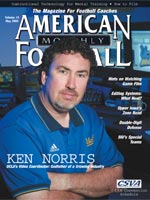AMERICAN FOOTBALL MONTHLY THE #1 RESOURCE FOR FOOTBALL COACHES
Article CategoriesAFM Magazine
|
Leaps and BoundsUCLA\'s Ken Norris has seen the video coordinator\'s role come a long, long way© More from this issue Marshall’s Brad Helton refers to him as “The Godfather of Video Coordinators.” But like most of his colleagues, UCLA’s Ken Norris is a cipher unless you are intimately familiar with his work. Over the years, Norris has worked with and for a number of football giants – men such as George Allen, Terry Donahue, John Robinson and Norv Turner. Norris has been a big help to the coaches for whom he has worked. But like all good video coordinators, he is too busy doing his work to bask in adulation or reflected glory. Kentucky running backs coach Ron Caragher learned of the demands put upon Norris when Caragher played and coached at UCLA from 1985-2002. “When we’d fly back from a road game (the team) would go home, but the Ken Norrises of the world would ....The full article can only be seen by subscribers. Subscribe today!
|
|
|||||||
| HOME |
MAGAZINE |
SUBSCRIBE | ONLINE COLUMNISTS | COACHING VIDEOS |
Copyright 2026, AmericanFootballMonthly.com
All Rights Reserved





